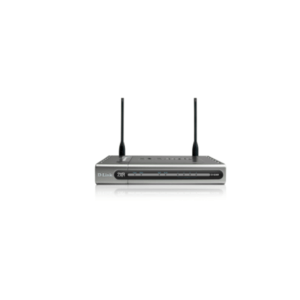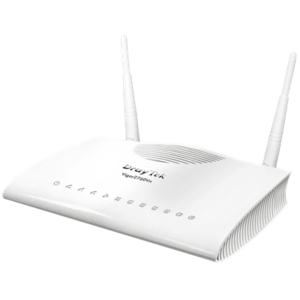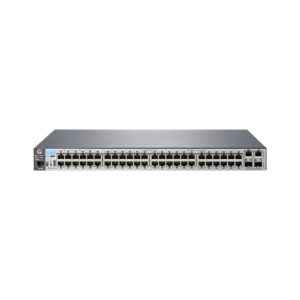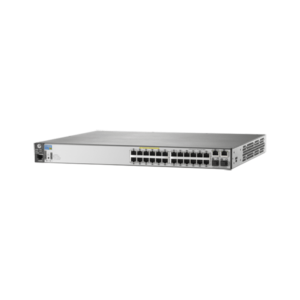Description
Specifications :
|
Model |
RG-S2652G-I |
|
|
Model |
RG-S2628G-I |
RG-S2652G-I |
|
Ports |
24 10/100BASE-T ports |
48 10/100BASE-T ports |
|
Fan Slots |
Fanless |
|
|
Management Ports |
1 console port |
|
|
Switching Capacity |
64Gbps |
|
|
Packet Forwarding Rate |
14.1Mpps |
17.7Mpps |
|
Port Buffer |
1MB |
2MB |
|
ARP Table |
130 |
|
|
MAC Address |
16K |
|
|
Routing Table Size (IPv4/IPv6) |
32/16 |
|
|
ACL Entries |
500 |
1000 |
|
VLAN |
4K 802.1Q VLAN, Port-based VLAN, Protocol Based VLAN, Private VLAN,Share VLAN, Voice VLAN, Guest VLAN, Q-in-Q, GVRP |
|
|
QinQ |
Basic QinQ |
|
|
Link Aggregation |
AP, LACP |
|
|
Port Mirroring |
Many-to-one mirroring, Flow-based mirroring, Over Devices Mirroring, AP-port Mirroring, RSPAN |
|
|
Spanning Tree Protocols |
IEEE802.1d STP, IEEE802.1w RSTP, standard 802.1s MSTP, Port Fast, BPDU Filter, BPDU Guard, TC Guard, TC Protection, |
|
|
DHCP |
DHCP Relay, DHCP Snooping. DHCP Client |
|
|
Multiple Spanning Tree (MST) Instances |
64 |
|
|
Maximum Aggregation Port (AP) |
120 |
|
|
VSU (Virtual Switch Unit) |
Up to 8 stack members |
|
|
L2 Features |
MAC, ARP, VLAN, Basic QinQ, Link Aggregation, Mirroring, STP, RSTP, MSTP, Broadcast storm control, MLD Snooping, DHCP, Jumbo Frame |
|
|
Layer 2 Protocols |
IEEE802.3, IEEE802.3u, IEEE802.3z, IEEE802.3x, IEEE802.3ad, IEEE802.1p, IEEE802.1x, IEEE802.3ab, IEEE802.1Q, IEEE802.1d, IEEE802.1w, IEEE802.1s, IGMPSnooping v1/v2 |
|
|
Layer 3 Features |
IPv4 static routing, IPv6 static routing |
|
|
Layer 3 Protocols (IPv4) |
Static routing |
|
|
IPv4 Features |
IPv4 ACL, Ping, Traceroute |
|
|
IPv6 Features |
ICMPv6, IPv6 Ping, IPv6 Tracert, Manually configure local address, Automatically create local address, Neighbor discovery, 0-64 any length mask |
|
|
Basic IPv6 Protocols |
IPv6 host management related information |
|
|
IPv6 Routing Protocols |
Static routing |
|
|
Multicast |
IGMP snooping, IVGL mode, IGMP filter and IGMP fast leave; |
|
|
ACL |
Standard IP ACL (IP-based hardware ACL) |
|
|
QoS |
802.1p/DSCP/TOS traffic classification; Multiple queue scheduling mechanisms, such as SP, WRR, DRR, SP+WRR, SP+DRR; RED / WRED; Input / output port-based speed limit; Port-based traffic recognition; Each port supports 8 queue priorities |
|
|
IPv6 ACL |
Support |
|
|
Reliability |
VSU (virtualization technology for virtualizing multiple devices into 1), CPP, RLDP (Rapid Link Detection Protocol); |
|
|
Security |
DHCP, ICMP, IP Source Guard, DOS Protection |
|
|
Manageability |
SNMPv1/v2/v3, CLI (Telnet/Console), RMON (1, 2, 3, 9), SSH, Syslog, NTP/SNTP, Web |
|
|
Smart Temperature Control |
Fan speed auto-adjustment; Fan malfunction alerts; Fan status check |
|
|
Smart Power Supply |
Power management |
|
|
Other Protocols |
FTP, TFTP, DNS client, DNS static |
|
|
Dimensions (W x D x H) (mm) |
440 × 200 × 44 |
440 × 260 × 44 |
|
Rack Height |
1RU |
|
|
Weight |
3.9kg |
4.2kg |
|
MTBF |
>200K hours |
|
|
Power Supply |
AC input: |
AC input: |
|
Power Consumption |
17W |
28W |
|
Temperature |
Operating temperature: 0°C to 50°C |
|
|
Storage temperature: -20°C to 70°C |
||
|
Humidity |
Operating humidity: 10% to 90%RH |
|
|
Storage humidity: 5% to 95%RH |
||
|
Operating Altitude |
-500M to 5,000M |
|
Features
Flexible and Complete Security Control Policies
- Adopt several internal security mechanisms to effectively avoid and control virus spreading and network traffic attacks. In this manner, the switches can prevent illegal users from using the network and meanwhile, guarantee the rational utilization of networks by legal users. The mechanisms include the static and dynamic security binding of ports, port isolation, various hardware ACL controls, bandwidth rate restriction based on data streams, and binding multiple of information in user access control. In this manner, the switches meet the requirements of corporate and campus networks to strengthen the control on visitors and communication restriction of unauthorized users.
- Isolate the users’ communication information from each other by setting ports to protected ports to ensure information security without occupying VLAN resources
- Effectively curb the ARP gateway spoofing and ARP host spoofing that become increasingly rampant on the network by adopting the dedicated hardware-based anti-ARP spoofing function and ensure normal network access
- Permit the DHCP response of only the trusted ports by leveraging the DHCP snooping feature to prevent unauthorized setup of the DHCP Servers from disturbing the IP address allocation and management and impacting normal network use. Furthermore, underpinned by the powerful DHCP snooping, the The RG-S2600G-I series switches can effectively prevent ARP host spoofing and source IP address spoofing in cases where DHCP provides dynamic IP address assignment by dynamically monitoring ARP and checking source IP addresses.
- Web and Telent access control based on the source IP address prevents illegal personnel and hackers from attacking and controlling devices to strengthen the security of devices.
- Encrypting management information in the process of Telnet and SNMP by using Secure Shell (SSH) and SNMPv3 ensures the security of management information and prevents hackers from launching attacks and controlling devices and protect the network against interference and sniffing.
- With multiple inherent security mechanisms including the static and dynamic port binding, port isolation, multiple types of hardware ACL (for example, expert-level ACL, time-based ACL), traffic-based bandwidth rate limiting, and multi-element binding of user secure access control, the RG-S2600G-I series switches prevent virus spreading and network traffic attacks and controls unauthorized network use.
High Reliability
- The Network Foundation Protection Policy (NFPP) classifies packets (management, forwarding, and protocol), restricts their rates, and monitors their attacks to support double protection of the CPU and channel bandwidth against attacks. In this manner, the switches can ensure the normal forwarding of packets and the normal status of protocols, keeping network stability.
- The spanning tree protocols 802.1D, 802.1w, and 802.1s support rapid convergence, enhance fault tolerance capability, and ensure the normal operation of networks and load balancing of links that properly utilize network channels and provide redundant links. The PortFast function greatly shortens thestandard convergence time of spanning tree protocols which ranges from 30 to 50 seconds. The BPDU guard function avoids loops in the spanning tree protocols.
Multi-Service Support
- With more and more services on the network, bandwidth guarantee becomes increasingly important. To avoid non-emergent services from occupying the bandwidth of emergent services, the RG-S2600G-I adopts complete QoS mechanisms to deploy multiple services.
- Support QoS policies of 802.1P, DSCP, IP TOS, and flow filtering at Layers 2 through 7 and provide traffic classification and flow control for MAC, IP, and application streams. The switches also support flow policies based on bandwidth control and forwarding priorities and allow networks to provide different qualities of services for different applications as required.
- Support IPv6-based QoS guarantee. The switches can identify different applications in the IPv6 environment and provide different qualities of services to ensure the bandwidth of key services.
- Each port supports the outgoing queues of eight priorities. This allows network administrators to allocate bandwidth to applications in a fine manner and better ensures the deployment of services. The switches support SP, WRR, and DRR mechanisms to determine the sequence to handle packets. For example, SP ensures the preferred transmission of services in a certain queue whereas WRR grants equal opportunity to the services in all queues.
- Support the flexible bandwidth control based on the combinations of switch ports, MAC addresses, IP addresses, VLAN IDs, protocols, and applications. The rate restriction granularity reaches 64 kbps. Based on network security requirements, you can set the bandwidth for different service applications as required.
Convenient and Easy Utilization and Management
- Adopt flexible Gigabit RJ-45 interfaces and Gigabit fiber port . You can choose connection methods based on the network architecture.
- Support the mixed stacking of devices. The stacking allows unified management and utilization of devices, decreases the management cost, and meanwhile, supports the flexible combination and extension of ports to seamlessly expand capacities. In this manner, the network is highly flexible and scalable and the network management becomes simpler.
- Support synchronous monitoring on several ports. You can use one port to monitor the data streams of several ports at the same time. You can also monionly the incoming frames, outgoing frames, or frames in both directions to enhance the maintenance efficiency.
- Support the network time protocol (NTP) and simple network time protocol (SNTP) to ensure the accuracy of time on the switches. The protocols also ensure the time consistency with servers on the network, facilitating the analysis and fault diagnosis of log and traffic information.
- The Syslog allows the unified collection, maintenance, analysis, fault location, and backup of various log information and makes easier for network administrators to maintain and manage networks.
Green Energy Conservation Design
- The S2628G-I, S2652G-I switches adopts the fan-free and noise-free design that largely reduces power consumption and noises.






